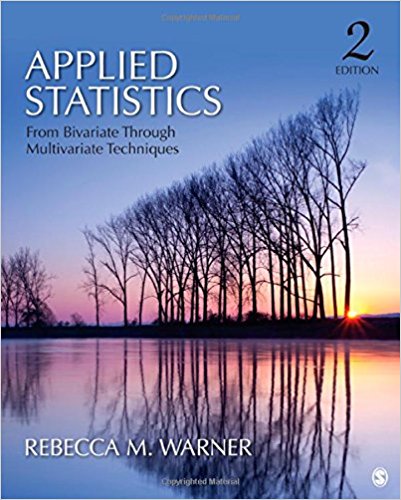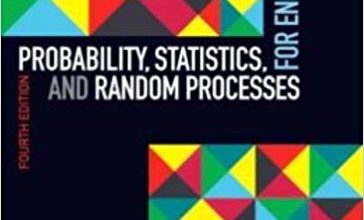
دانلود کتاب Applied Statistics: From Bivariate 2nd
برای خرید و دانلود کتاب Applied Statistics: From Bivariate Through Multivariate Techniques با گیگاپیپر مکاتبه کنید. نسخه Epub و پی دی اف PDF تیدبل شده ان در گیگاپیپر موجود است و به محض واریز ارسال می شود. چند صفحه نمونه از کتاب “آمار کاربردی: از دو بعد از طریق چند متغیره” در انتهای پست اورده شده است.

Applied Statistics : From Bivariate Through Multivariate Techniques
Author: Rebecca (Becky) M (Margaret) Warner
Publisher: Thousand Oaks : SAGE Publications, 2012
Edition/Format: eBook : Document : English
Summary:
Rebecca M. Warner’s Applied Statistics: From Bivariate Through Multivariate Techniques, Second Edition provides a clear introduction to widely used topics in bivariate and multivariate statistics, including multiple regression, discriminant analysis, MANOVA, factor analysis, and binary logistic regression. The approach is applied and does not require formal mathematics; equations are accompanied by verbal explanations. Students are asked to think about the meaning of equations. Each chapter presents a complete empirical research example to illustrate the application of a specific method.
درباره نویسنده کتاب Rebecca (Becky) M (Margaret) Warner
About the author (2012)
Rebecca M. Warner received a B.A. from Carnegie-Mellon University in Social Relations in 1973 and a Ph.D. in Social Psychology from Harvard in 1978. She has taught statistics for more than 25 years: from Introductory and Intermediate Statistics to advanced topics seminars in Multivariate Statistics, Structural Equation Modeling, and Time Series Analysis. She is currently a Full Professor in the Department of Psychology at the University of New Hampshire. She is a Fellow in the Association for Psychological Science and a member of the American Psychological Association, the International Association for Relationships Research, the Society of Experimental Social Psychology, and the Society for Personality and Social Psychology. She has consulted on statistics and data management for the World Health Organization in Geneva and served as a visiting faculty member at Shandong Medical University in China.
اطلاعات کتاب شناختی Applied Statistics: From Bivariate Through Multivariate Techniques
Bibliographic information
QR code for Applied Statistics: From Bivariate Through Multivariate Techniques
Title Applied Statistics: From Bivariate Through Multivariate Techniques: From Bivariate Through Multivariate Techniques
Author Rebecca M. Warner
Edition illustrated
Publisher SAGE, 2012
ISBN 141299134X, 9781412991346
Length 1172 pages
Subjects Mathematics
› Probability & Statistics
› Multivariate Analysis
Mathematics / Probability & Statistics / Multivariate Analysis
Psychology / Statistics
Social Science / Research
Social Science / Statistics
دانلود رایگان Applied Statistics: From Bivariate
بخشی از کتاب بصورت رایگان آورده شده است.
[pdf-embedder url=”http://www.GigaPaper.ir/wp-content/uploads/2018/01/9781412991346-Applied-Statistics-Watermark.pdf” title=”9781412991346 Applied Statistics Watermark”]
Applied Statistics: From Bivariate Through Multivariate Techniques
by Rebecca M. Warner
Publisher: SAGE Publications, Inc
Print ISBN: 9781412991346, 141299134X
eText ISBN: 9781483305974, 148330597X
Edition: 2nd
Pages: 1208
Copyright year: 2013
فهرست مطالب کتاب Applied Statistics: From Bivariate through Multivariate Techniques 9780761927723
Applied Statistics: From Bivariate through Multivariate Techniques
Warner, Rebecca M.
ISBN-13: 9780761927723
Table of Contents
Preface
Acknowledgments
Chapter 1. Review of Basic Concepts
1.1 Introduction
1.2 A Simple Example of a Research Problem
1.3 Discrepancies Between Real and Ideal Research Situations
1.4 Samples and Populations
1.5 Descriptive Versus Inferential Uses of Statistics
1.6 Levels of Measurement and Types of Variables
1.7 The Normal Distribution
1.8 Research Design
1.9 Parametric Versus Nonparametric Statistics
1.10 Additional Implicit Assumptions
1.11 Selection of an Appropriate Bivariate Analysis
1.12 Summary
Comprehension Questions
Chapter 2. Introduction to SPSS: Basic Statistics, Sampling Error, and Confidence Intervals
2.1 Introduction
2.2 Research Example: Description of a Sample of HR Scores
2.3 Sample Mean (M)
2.4 Sum of Squared Deviations and Sample Variance (s2)
2.5 Degrees of Freedom (df) for a Sample Variance
2.6 Why Is There Variance?
2.7 Sample Standard Deviation (s)
2.8 Assessment of Location of a Single X Score Relative to a Distribution of Scores
2.9 A Shift in Level of Analysis: The Distribution of Values of M Across Many Samples From the Same Population
2.10 An Index of Amount of Sampling Error: The Standard Error of the Mean (oM)
2.11 Effect of Sample Size (N) on the Magnitude of the Standard Error (oM )
2.12 Sample Estimate of the Standard Error of the Mean (SEM)
2.13 The Family of t Distributions
2.14 Confidence Intervals
2.15 Summary
Appendix on SPSS
Comprehension Questions
Chapter 3. Statistical Significance Testing
3.1 The Logic of Null Hypothesis Significance Testing (NHST)
3.2 Type I Versus Type II Error
3.3 Formal NHST Procedures: The z Test for a Null Hypothesis About One Population Mean
3.4 Common Research Practices Inconsistent With Assumptions and Rules for NHST
3.5 Strategies to Limit Risk of Type I Error
3.6 Interpretation of Results
3.7 When Is a t Test Used Instead of a z Test?
3.8 Effect Size
3.9 Statistical Power Analysis
3.10 Numerical Results for a One-Sample t Test Obtained From SPSS
3.11 Guidelines for Reporting Results
3.12 Summary
Comprehension Questions
Chapter 4. Preliminary Data Screening
4.1 Introduction: Problems in Real Data
4.2 Quality Control During Data Collection
.3ExampleofanSPSSDataWorkshee
4.4 Identification of Errors and Inconsistencies
4.5 Missing Values
4.6 Empirical Example of Data Screening for Individual Variables
.7IdentificationandHandlingofOutliers
4.8 Screening Data for Bivariate Analyses
4.9 Nonlinear Relations
4.10 Data Transformations
4.11 Verifying That Remedies Had the Desired Effects
.12MultivariateDatcreenin
4.13 Reporting Preliminary Data Screenin
4.14 Summary and Checklist for Data Screening
Comprehension Questions
Chapter 5. Comparing Group Means Using the Independent Samples t Test
.1ResearchSituationsWheretheIndependentSamplestTestIsUsed
5.2 A Hypothetical Research Example
5.3 Assumptions About the Distribution of Scores on the Quantitative Dependent Variable
5.4 Preliminary Data Screening
5.5 Issues in Designing a Study
5.6 Formulas for the Independent Samples t Test
5.7 Conceptual Basis: Factors That Affect the Size of the t Ratio
5.8 Effect Size Indexes for t
5.9 Statistical Power and Decisions About Sample Size for the Independent Samples t Test
5.10 Describing the Nature of the Outcome
5.11 SPSS Output and Model Results Section
5.12 Summary
Comprehension Questions
Chapter 6. One-Way Between-Subjects Analysis of Variance
6.1 Research Situations Where One-Way Between-Subjects Analysis of Variance (ANOVA) Is Used
6.2 Hypothetical Research Example
6.3 Assumptions About Scores on the Dependent Variable for One-Way Between-S ANOVA
6.4 Issues in Planning a Study
6.5 Data Screening
6.6 Partition of Scores Into Components
6.7 Computations for the One-Way Between-S ANOVA
6.8 Effect Size Index for One-Way Between-S ANOVA
6.9 Statistical Power Analysis for One-Way Between-S ANOVA
6.10 Nature of Differences Among Group Means
6.11 SPSS Output and Model Results
6.12 Summary
Comprehension Questions
Chapter 7. Bivariate Pearson Correlation
7.1 Research Situations Where Pearson r Is Used
7.2 Hypothetical Research Example
7.3 Assumptions for Pearson r
7.4 Preliminary Data Screening
7.5 Design Issues in Planning Correlation Research
7.6 Computation of Pearson r
7.7 Statistical Significance Tests for Pearson r
7.8 Setting Up CIs for Correlations
7.9 Factors That Influence the Magnitude and Sign of Pearson r
7.10 Pearson r and r2 as Effect Size Indexes
7.11 Statistical Power and Sample Size for Correlation Studies
7.12 Interpretation of Outcomes for Pearson r
7.13 SPSS Output and Model Results Write-Up
7.14 Summary
applied statistics from bivariate through multivariate techniques second edition pdf
Comprehension Questions
Chapter 8. Alternative Correlation Coefficients
8.1 Correlations for Different Types of Variables
8.2 Two Research Examples
8.3 Correlations for Rank or Ordinal Scores
8.4 Correlations for True Dichotomies
8.5 Correlations for Artificially Dichotomized Variables
8.6 Assumptions and Data Screening for Dichotomous Variables
8.7 Analysis of Data: Dog Ownership and Survival After a Heart Attack
8.8 Chi-Square Test of Association (Computational Methods for Tables of Any Size)
8.9 Other Measures of Association for Contingency Tables
8.10 SPSS Output and Model Results Write-Up
8.11 Summary
Comprehension Questions
Chapter 9. Bivariate Regression
9.1 Research Situations Where Bivariate Regression Is Used
9.2 A Research Example: Prediction of Salary From Years of Job Experience
9.3 Assumptions and Data Screening
9.4 Issues in Planning a Bivariate Regression Study
9.5 Formulas for Bivariate Regression
9.6 Statistical Significance Tests for Bivariate Regression
9.7 Setting Up Confidence Intervals Around Regression Coefficients
9.8 Factors That Influence the Magnitude and Sign of b
9.9 Effect Size/Partition of Variance in Bivariate Regression
9.10 Statistical Power
9.11 Raw Score Versus Standard Score Versions of the Regression Equation
9.12 Removing the Influence of X From the Y Variable by Looking at Residuals From Bivariate Regression
9.13 Empirical Example Using SPSS
9.14 Summary
Comprehension Questions
Chapter 10. Adding a Third Variable: Preliminary Exploratory Analyses
10.1 Three-Variable Research Situations
10.2 First Research Example
applied statistics from bivariate through multivariate techniques free download
10.3 Exploratory Statistical Analyses for Three-Variable Research Situations
10.4 Separate Analysis of X1, Y Relationship for Each Level of the Control Variable X2
10.5 Partial Correlation Between X1 and Y Controlling for X2
10.6 Understanding Partial Correlation as the Use of Bivariate Regression to Remove Variance Predictable by X2 From Both X1 and Y
10.7 Computation of Partial r From Bivariate Pearson Correlations
10.8 Intuitive Approach to Understanding Partial r
10.9 Significance Tests, Confidence Intervals, and Statistical Power for Partial Correlations
10.10 Interpretation of Various Outcomes for rY1.2 and rY1
10.11 Two-Variable Causal Models
10.12 Three-Variable Models: Some Possible Patterns of Association Among X1, Y, and X2
10.13 Mediation Versus Moderation
10.14 Model Results
10.15 Summary
Comprehension Questions
Chapter 11. Multiple Regression With Two Predictor Variables
11.1 Research Situations Involving Regression With Two Predictor Variables
11.2 Hypothetical Research Example
11.3 Graphic Representation of Regression Plane
11.4 Semipartial (or “Part”) Correlation
11.5 Graphic Representation of Partition of Variance in Regression With Two Predictors
11.6 Assumptions for Regression With Two Predictors
11.7 Formulas for Regression Coefficients, Significance Tests, and Confidence Intervals
11.8 SPSS Regression Results
11.9 Conceptual Basis: Factors That Affect the Magnitude and Sign of B and b Coefficients in Multiple Regression With Two Predictors
11.10 Tracing Rules for Causal Model Path Diagrams
11.11 Comparison of Equations for B, b, pr, and sr
11.12 Nature of Predictive Relationships
11.13 Effect Size Information in Regression With Two Predictors
11.14 Statistical Power
11.15 Issues in Planning a Study
11.16 Use of Regression With Two Predictors to Test Mediated Causal Models
11.17 Results
11.18 Summary
applied statistics from bivariate through multivariate techniques pdf download
Comprehension Questions
Chapter 12. Dummy Predictor Variables and Interaction Terms in Multiple Regression
12.1 Research Situations Where Dummy Predictor Variables Can Be Used
12.2 Empirical Example
12.3 Screening for Violations of Assumptions
12.4 Issues in Planning a Study
12.5 Parameter Estimates and Significance Tests for Regressions With Dummy Variables
12.6 Group Mean Comparisons Using One-Way Between-S ANOVA
12.7 Three Methods of Coding for Dummy Variables
12.8 Regression Models That Include Both Dummy and Quantitative Predictor Variables
12.9 Tests for Interaction (or Moderation)
12.10 Interaction Terms That Involve Two Quantitative Predictors
12.11 Effect Size and Statistical Power
12.12 Nature of the Relationship and/or Follow-Up Tests
12.13 Results
12.14 Summary
Comprehension Questions
Chapter 13. Factorial Analysis of Variance
13.1 Research Situations and Research Questions
13.2 Screening for Violations of Assumptions
13.3 Issues in Planning a Study
1PDF-XCHANGE aPRO al ANOVA
3.4EmpiricalExample:DescriptionofHypotheticalDat
13.5 Computations for Between-S Factorial ANOVA
13.6 Conceptual Basis: Factors That Affect the Size of Sums of Squares andFRatiosinFactori
13.7 Effect Size Estimates for Factorial ANOVA
13.8 Statistical Power
1www.tracker-software.com
3.9NatureoftheRelationships,Follow-UpTests,andInformationtoIncludeintheResults
13.10 Factorial ANOVA Using the SPSS GLM Procedure
13.11 Summary
Appendix: Nonorthogonal Factorial ANOVA (ANOVA With Unbalanced Numbers of Cases in the Cells or Groups)
Comprehension Questions
ChapClick esto h Mbuy redNOW!
ter14.MultipleRegrsionWitoreThanTwoPictors
14.1 Research Questions
14.2 Empirical Example
14.3 Screening for Violations of Assumptions
1http://www.tracker-software.com/buy-now
4.4IssuesinPlanningaStudy
14.5 Computation of Regression Coefficients With k Predictor Variables
14.6 Methods of Entry for Predictor Variables
14.7 Variance Partitioning in Regression for Standard or Simultaneous Regression Versus Regressions That Involve a Series of Steps
14.8 Significance Test for an Overall Regression Model
14.9 Significance Tests for Individual Predictors in Multiple Regression
14.10 Effect Size
14.11 Changes in F and R as Additional Predictors Are Added to a Model in Sequential or Statistical Regression
14.12 Statistical Power
14.13 Nature of the Relationship Between Each X Predictor and Y (Controlling for Other Predictors)
14.14 Assessment of Multivariate Outliers in Regression
14.15 SPSS Example and Results
14.16 Summary
Appendix 14.A: A Review of Matrix Algebra Notation and Operations and Application of Matrix Algebra to Estimation of Slope Coefficients for Regression With More Than k Predictor Variables Appendix 14.B: Tables for Wilkinson and Dallal (1981) Test of Significance of Multiple R2 in Method = Forward Statistical Regression
Comprehension Questions
Chapter 15. Analysis of Covariance
15.1 Research Situations and Research Questions
15.2 Empirical Example
15.3 Screening for Violations of Assumptions
15.4 Variance Partitioning in ANCOVA
15.5 Issues in Planning a Study
15.6 Formulas for ANCOVA
15.7 Computation of Adjusted Effects and Adjusted Y* Means
15.8 Conceptual Basis: Factors That Affect the Magnitude of SSAadj and SSresidual and the Pattern of Adjusted Group Means
15.9 Effect Size
15.10 Statistical Power
15.11 Nature of the Relationship and Follow-Up Tests: Information to Include in the Results Section
15.12 SPSS Analysis and Model Results
15.13 Additional Discussion of ANCOVA Results
15.14 Summary
Appendix: Alternative Methods for the Analysis of Pretest/Posttest Data
Comprehension Questions
Chapter 16. Discriminant Analysis
16.1 Research Situations and Research Questions
16.2 Introduction of an Empirical Example
16.3 Screening for Violations of Assumptions
16.4 Issues in Planning a Study
16.5 Equations for Discriminant Analysis
16.6 Conceptual Basis: Factors That Affect the Magnitude of Wilks’s Lambda
16.7 Effect Size
16.8 Statistical Power and Sample Size Recommendations
16.9 Follow-Up Tests to Assess What Pattern of Scores Best Differentiates Groups
16.10 Results
16.11 One-Way ANOVA on Scores on Discriminant Functions
16.12 Summary
applied statistics from bivariate through multivariate techniques 2nd edition
Appendix: Eigenvalue/Eigenvector Problem
Comprehension Questions
Chapter 17. Multivariate Analysis of Variance
17.1 Research Situations and Research Questions
17.2 Introduction of the Initial Research Example: A One-Way MANOVA
17.3 Why Include Multiple Outcome Measures?
17.4 Equivalence of MANOVA and DA
17.5 The General Linear Model
17.6 Assumptions and Data Screening
17.7 Issues in Planning a Study
17.8 Conceptual Basis of MANOVA and Some Formulas for MANOVA
17.9 Multivariate Test Statistics
17.10 Factors That Influence the Magnitude of Wilks’s Lambda
17.11 Effect Size for MANOVA
17.12 Statistical Power and Sample Size Decisions
17.13 SPSS Output for a One-Way MANOVA: Career Group Data From Chapter 16
17.14 A 2 x 3 Factorial MANOVA of the Career Group Data
17.15 A Significant Interaction in a 3 x 6 MANOVA
17.16 Comparison of Univariate and Multivariate Follow-Up Analyses for MANOVA
17.17 Summary
17.17 Summary
Comprehension Questions
Chapter 18. Principal Components and Factor Analysis
18.1 Research Situations
18.2 Path Model for Factor Analysis
18.3 Factor Analysis as a Method of Data Reduction
18.4 Introduction of an Empirical Example
18.5 Screening for Violations of Assumptions
18.6 Issues in Planning a Factor Analytic Study
18.7 Computation of Loadings
18.8 Steps in the Computation of Principal Components or Factor Analysis
18.9 Analysis 1: Principal Components Analysis of Three Items Retaining All Three Components
18.10 Analysis 2: Principal Component Analysis of Three Items Retaining Only the First Component
18.11 Principal Components Versus Principal Axis Factoring
18.12 Analysis 3: PAF of Nine Items, Two Factors Retained, No Rotation
18.13 Geometric Representation of Correlations Between Variables and Correlations Between Components or Factors
18.14 The Two Multiple Regressions
18.15 Analysis 4: PAF With Varimax Rotation
18.16 Questions to Address in the Interpretation of Factor Analysis
18.17 Results Section for Analysis 4: PAF With Varimax Rotation
18.18 Factor Scores Versus Unit-Weighted Composites
18.19 Summary of Issues in Factor Analysis
18.20 Optional: Brief Introduction to Concepts in Structural Equation Modeling
Appendix: The Matrix Algebra of Factor Analysis
Comprehension Questions
Chapter 19. Reliability, Validity, and Multiple-Item Scales
19.1 Assessment of Measurement Quality
19.2 Cost and Invasiveness of Measurements
19.3 Empirical Examples of Reliability Assessment
19.4 Concepts From Classical Measurement Theory
19.5 Use of Multiple-Item Measures to Improve Measurement Reliability
19.6 Three Methods for the Computation of Summated Scales
19.7 Assessment of Internal Homogeneity for Multiple-Item Measures
19.8 Correlations Among Scores Obtained Using Different Methods of Summing Items
19.9 Validity Assessment
19.10 Typical Scale Development Study
19.11 Summary
Appendix: The CESD Scale
Comprehension Questions
Chapter 20. Analysis of Repeated Measures
20.1 Introduction
20.2 Empirical Example: Experiment to Assess Effect of Stress on Heart Rate
20.3 Discussion of Sources of Within-Group Error in Between-S Versus Within-S Data
20.4 The Conceptual Basis for the Paired Samples t Test and One-Way Repeated Measures ANOVA
20.5 Computation of a Paired Samples t Test to Compare Mean HR Between Baseline and Pain Conditions
20.6 SPSS Example: Analysis of Stress/HR Data Using a Paired Samples t Test
20.7 Comparison Between Independent Samples t Test and Paired Samples t Test
20.8 SPSS Example: Analysis of Stress/HR Data Using a Univariate One-Way Repeated Measures ANOVA
20.9 Using the SPSS GLM Procedure for Repeated Measures ANOVA
20.10 Screening for Violations of Assumptions in Univariate Repeated Measures
20.11 The Greenhouse-Geisser e and Huynh Feldt e Correction Factors
20.12 MANOVA Approach to Analysis of Repeated Measures Data
20.13 Effect Size
20.14 Statistical Power
20.15 Planned Contrasts
20.16 Results
20.17 Design Problems in Repeated Measures Studies
20.18 More Complex Designs
20.19 Alternative Analyses for Pretest and Posttest Scores
20.20 Summary
Comprehension Questions
Chapter 21. Binary Logistic Regression
21.1 Research Situations
21.2 Simple Empirical Example: Dog Ownership and Odds of Death
21.3 Conceptual Basis for Binary Logistic Regression Analysis
2PDF-XCHANGE sPRO
1.4DefinitionandInterpretationofOdd
21.5 A New Type of Dependent Variable: The Logit
21.6 Terms Involved in Binary Logistic Regression Analysis
21.7 Analysis of Data for First Empirical Example: Dog Ownership/Death Study
21.8 Issues in Planning and Conducting a Study
2www.tracker-software.com
1.9MoreComplexModels
21.10 Binary Logistic Regression for Second Empirical Analysis: Drug Dose and Gender as Predictors of Odds of Death
21.11 Comparison of Discriminant Analysis to Binary Logistic Regression
21.12 Summary
CClick sto er buy l CNOW!
omprehensionQuestion
Appendix A: Proportions of AreaUndStandardNormaurve
Appendix B: Critical Values for t Distribution
Appendix C: Critical Values of F
Appendix D: Critical Values of Chi-Square
Appehttp://www.tracker-software.com/buy-now
ndixE:CriticalValuesoftheCorrelationCoefficient
Appendix F: Critical Values of the Studentized Range Statistic
Appendix G: Transformation of r (Pearson Correlation) to Fisher Z
Glossary
References
Index
About the Author
برای سفارش کتاب زیر هم می توانید با ما مکاتبه کنید.
Title: e-Study Guide for: Applied Statistics: From Bivariate Through Multivariate Techniques by Rebecca M. Warner, ISBN 9780761927723
Author: Cram101 Textbook Reviews
Subjects: science and math, education and teaching, mathematics, schools and teaching, teacher resources, statistics, applied
Format: AZW
دانلود رایگان Applied Statistics: From Bivariate Through Multivariate Techniques

جهت اطمینان از کیفیت کتاب، چند صفحه از ایبوک Applied Statistics: From Bivariate Through Multivariate Techniques بصورت رایگان آورده شده است.





![خرید کیندل امازون How to Flourish as a Psychotherapist دانلود ایبوک Brett Kahr در فرمت epub , azw و PDF ایبوک روانشناسی خرید از Amazon کیندل خرید کتاب کیندل Free Download How to Flourish as a Psychotherapist by [Kahr, Brett]](/wp-content/uploads/2019/02/51IfCyqH7KL%20GigaPaperIR-330x220.jpg)
